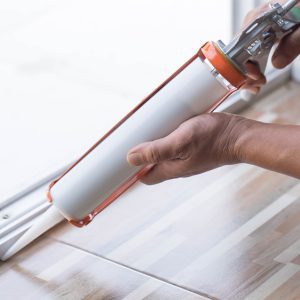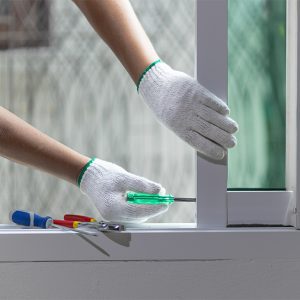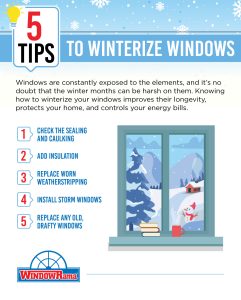
November 18, 2022 by WindowRama
5 Tips To Keep Your Energy Bill Down This Winter
Winter can be harsh on our homes, and being unprepared for the cold months can sometimes be a costly mistake.
Many of us scramble to change our HVAC filters, remove debris from our gutters and yards, and clean out the chimney when it’s about time to kick the furnace on. For our tips on how to keep your energy bill down, we are naturally going to focus on windows, but not only because it’s our area of expertise. The air passing through old, poorly insulated windows can be responsible for up to 30% of residential heating and cooling energy use.
Knowing how to winterize your windows allows you to take the correct measures to protect your home and control your energy bills. A quality window brings extra comfort indoors, keeps moisture out, and results in energy savings.

1. Sealing and Caulking
Air leaks, though often unseen or invisible to most homeowners, call for a regular inspection of windows.
A simple, affordable way to prepare your windows for winter and block drafts is to use caulk. Caulk is a flexible, waterproof material designed for sealing cracks and gaps in windows. It should definitely be included in your winterizing kit.
Caulk creates a waterproof seal on your windows to prevent drafts and moisture from entering the home. This prevents mold and reduces your energy consumption.
Caulk lasts for about five years on average. In colder areas, caulk degrades faster due to the extra moisture and the movement from expanding and contracting.
2. Add Insulation
To effectively winterize your windows, you’ll need to combine several solutions. Besides caulking, you can use window films, thermal treatments, and foam insulation kits.
Window Films
Insulating films help completely seal cracks and gaps, preventing drafts. This thin, clear plastic is applied inside the window to block air. The extra layer also reinforces your window’s R-value resulting in more significant energy savings.

Thermal Treatments
Thermal curtains are one of the least time-consuming ways to reduce heat loss from windows. They function similarly to your favorite duvet in keeping interiors warm. Not only do they block drafts but they also trap warm air.
High-quality curtains typically contain a high-density foam core to block heat loss and even soundproof your home. The curtains also mostly use a non-breathable material to prevent the curtain from absorbing condensed moisture.
The advantage of these curtains over other forms of window insulation is they provide year-round energy savings. During summer, they can trap the cool air inside for cozier interiors.
Foam Insulation Kits
If you spot larger gaps and cracks on your windows, use foam insulation rather than caulk. Foam insulation kits are ideal for sealing joints larger than 5/8″ in diameter.
3. Use Weatherstripping
Every window or door has weatherstripping integrated during installation to prevent air leaks. With time the weatherstripping wears out, bends and compresses, failing to work as intended. We recommend replacing worn weatherstripping to be sure you’ve tackled all the drafts around your windows.
Weatherstripping involves attaching a plastic, foam or felt strip to your window frame or sash. This creates a seal between the frame and sash when you lock or close your windows.
4. Install Storm Windows
Many window installation experts recommend removing screens during winter, especially for homes with single-pane windows. BuildingGreen says leaving screens through winter blocks up to 40% of the solar heat that would otherwise enter through your windows.
You may wonder how to winterize your windows after removing your window screens since you’ve reduced the existing barrier. One effective solution that will go a long way in lowering your energy bill is to replace window screens with storm window inserts. Storm windows offer a higher thermal barrier to prevent heat loss.
Also, window screens left in place are prone to damage due to trapped snow and ice between the screen and the window. And in casement windows, window screens can be a breeding ground for mold and mildew due to trapped condensation.
5. Replace Drafty Windows
Replacing windows is the ultimate solution for troubling drafts as it gives you long-lasting relief from high energy costs. The benefits you gain when installing waterproof or energy-efficient windows will be worth your investment.

You have two options when it comes to window replacement: inserts and full frame replacements.
Here are some signs that your windows need replacing:
- Your windows are substandard or old
- Your energy bill is soaring high despite caulking, weatherstripping and insulating your windows
- You want to winterize your home with quality windows that match your style and needs
- Your window frames and sash look worn and old
- The glass often collects condensation and seems extra foggy during winter
- Your windows are stuck in one position and you struggle to open or close them
Ready for window replacement? Understanding window energy performance can help you choose the right windows for your needs in addition to working with an expert.
Need Help Preparing Your Windows?
Winterizing your windows demands the utmost attention since they are responsible for more drafts than many areas in your home. A shoddy job on your windows can cost you money and much-needed comfort when winter arrives.
Get professional tips for all your window questions and find quality window replacements of all types from casement to double hung or specialty windows and more. Our licensed, insured professionals make sure products are installed according to the manufacturers’ recommendations and help keep your home cozy through the coldest months.
